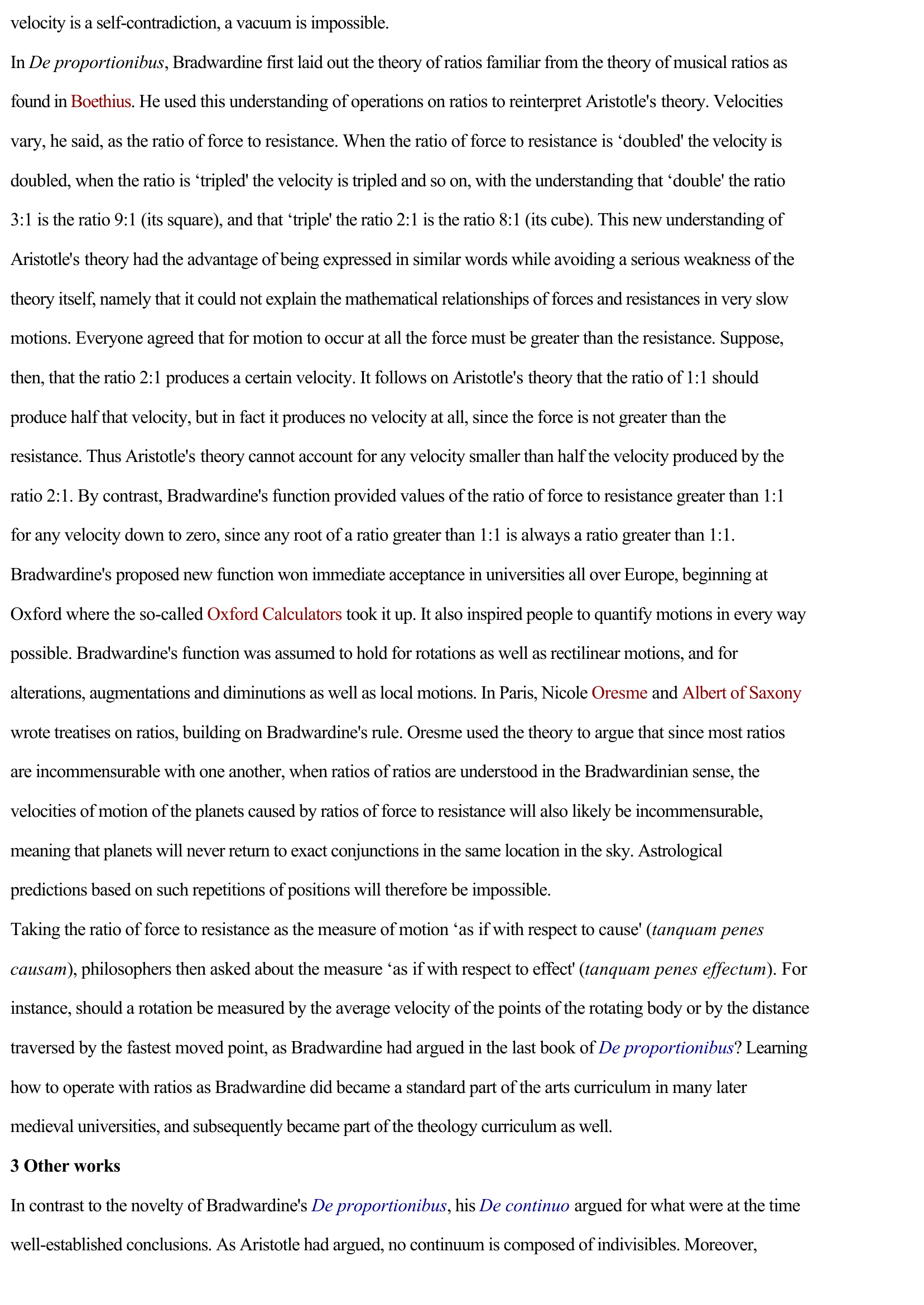Bradwardine, Thomas
Publié le 22/02/2012
Extrait du document
«
velocity is a self-contradiction, a vacuum is impossible.
In De proportionibus , Bradwardine first laid out the theory of ratios familiar from the theory of musical ratios as
found in Boethius .
He used this understanding of operations on ratios to reinterpret Aristotle 's theory.
Velocities
vary, he said, as the ratio of force to resistance.
When the ratio of force to resistance is ‘doubled' the velocity is
doubled, when the ratio is ‘tripled' the velocity is tripled and so on, with the understanding that ‘double' the ratio
3:1 is the ratio 9:1 (its square), and that ‘triple' the ratio 2:1 is the ratio 8:1 (its cube).
This new understanding of
Aristotle 's theory had the advantage of being expressed in similar words while avoiding a serious weakness of the
theory itself, namely that it could not explain the mathematical relationships of forces and resistances in very slow
motions.
Everyone agreed that for motion to occur at all the force must be greater than the resistance.
Suppose,
then, that the ratio 2:1 produces a certain velocity.
It follows on Aristotle 's theory that the ratio of 1:1 should
produce half that velocity, but in fact it produces no velocity at all, since the force is not greater than the
resistance.
Thus Aristotle 's theory cannot account for any velocity smaller than half the velocity produced by the
ratio 2:1.
By contrast, Bradwardine's function provided values of the ratio of force to resistance greater than 1:1
for any velocity down to zero, since any root of a ratio greater than 1:1 is always a ratio greater than 1:1.
Bradwardine's proposed new function won immediate acceptance in universities all over Europe, beginning at
Oxford where the so-called Oxford Calculators took it up.
It also inspired people to quantify motions in every way
possible.
Bradwardine's function was assumed to hold for rotations as well as rectilinear motions, and for
alterations, augmentations and diminutions as well as local motions.
In Paris, Nicole Oresme and Albert of Saxony
wrote treatises on ratios, building on Bradwardine's rule.
Oresme used the theory to argue that since most ratios
are incommensurable with one another, when ratios of ratios are understood in the Bradwardinian sense, the
velocities of motion of the planets caused by ratios of force to resistance will also likely be incommensurable,
meaning that planets will never return to exact conjunctions in the same location in the sky.
Astrological
predictions based on such repetitions of positions will therefore be impossible.
Taking the ratio of force to resistance as the measure of motion ‘as if with respect to cause' (tanquam penes
causam ), philosophers then asked about the measure ‘as if with respect to effect' (tanquam penes effectum ).
For
instance, should a rotation be measured by the average velocity of the points of the rotating body or by the distance
traversed by the fastest moved point, as Bradwardine had argued in the last book of De proportionibus ? Learning
how to operate with ratios as Bradwardine did became a standard part of the arts curriculum in many later
medieval universities, and subsequently became part of the theology curriculum as well.
3 Other works
In contrast to the novelty of Bradwardine's De proportionibus , his De continuo argued for what were at the time
well-established conclusions.
As Aristotle had argued, no continuum is composed of indivisibles.
Moreover,.
»
↓↓↓ APERÇU DU DOCUMENT ↓↓↓
Liens utiles
- Les compliments de thomas diafoirus
- MONDE ABSENT (Le) d'Henri Thomas (résumé)
- Art POÉTIQUE FRANÇAIS, de Thomas Sebillet / de Jean Vauquelin de La Fresnaye
- QUESTIONS DISPUTÉES, Thomas d’Aquin (saint) (résumé)
- TRISTAN de Thomas d’Angleterre : Fiche de lecture

































